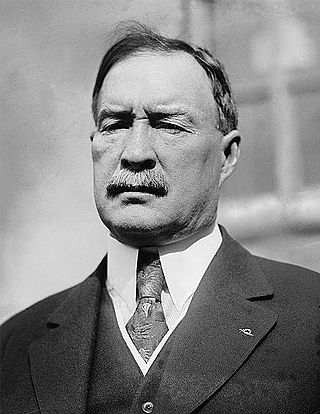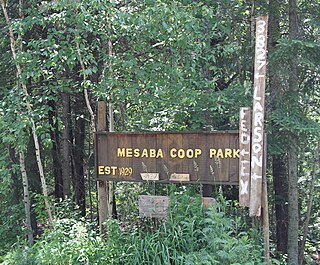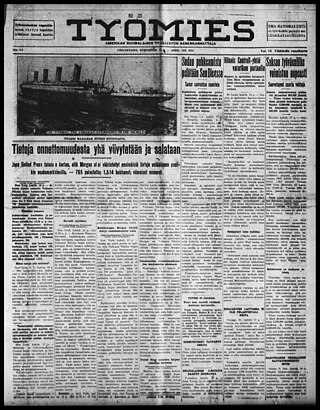Related Research Articles

The Industrial Workers of the World (IWW), whose members are nicknamed "Wobblies", is an international labor union founded in Chicago in 1905. The nickname's origin is uncertain. Its ideology combines general unionism with industrial unionism, as it is a general union, subdivided between the various industries which employ its members. The philosophy and tactics of the IWW are described as "revolutionary industrial unionism", with ties to socialist, syndicalist, and anarchist labor movements.

The Minnesota Farmer–Labor Party (FLP) was a left-wing American political party in Minnesota between 1918 and 1944. The FLP largely dominated Minnesota politics during the Great Depression. It was one of the most successful statewide third party movements in United States history and the longest-lasting affiliate of the national Farmer–Labor movement. At its height in the 1920s and 1930s, FLP members included three Minnesota governors, four United States senators, eight United States representatives and a majority in the Minnesota legislature.
Carl Skoglund was a Swedish-American socialist, affectionately called Skogie by all his American friends and comrades. He was born in Dalsland and went to the United States in 1911, sailing in steerage first on board the Swedish ship Oslo, sailing from Gothenburg to Hull, England; and thence on the White Star Line ship Cymric, sailing from Liverpool to Boston; his destination was Minneapolis. After spending some time in the Industrial Workers of the World he became one of the founders of the American Communist Party and later became a Trotskyist and one of the co-founders of the Socialist Workers Party.
Matti Valentin Huhta, better known by his pen name T-Bone Slim, was an American humorist, poet, songwriter, hobo, and labor activist, who played a prominent role in the Industrial Workers of the World (IWW).

Work People's College was a radical labor college established in Smithville (Duluth), then a suburb of Duluth, Minnesota, in 1907 by the Finnish Socialist Federation of the Socialist Party of America. School administrators and faculty were sympathetic to the syndicalist left wing of the Finnish labor movement and the institution came into the orbit of the Industrial Workers of the World during the 1914-1915 factional battle that split the Finnish Federation. The school ceased operation in 1941.

The Finnish Labour Temple is a Finnish-Canadian cultural and community centre and a local landmark located at 314 Bay Street in the Finnish quarter in Thunder Bay, Ontario.

William Leighton Carss was a U.S. Representative from Minnesota; born in Pella, Marion County, Iowa and subsequently moved with his parents to Des Moines, Iowa, in 1867. There he attended the public schools, studied civil and mechanical engineering and followed that profession for a number of years. He moved to St. Louis County, Minnesota in 1893 and settled in Proctor where he found work as a locomotive engineer and became a member of the Brotherhood of Locomotive Engineers. Carss was elected as a Farmer-Labor candidate to the 66th congress from Minnesota's 8th congressional district.

Tie Vapauteen was a Finnish language monthly magazine published by Finnish members of the Industrial Workers of the World (IWW) in the United States from 1919 to 1937. The magazine advanced an explicitly syndicalist position marked by Marxian class analysis. The magazine featured regular analysis of American industry, working life, and political commentary alongside poetry, fiction, and humor. The publication was also closely tied to the Finnish Work People's College in Duluth, Minnesota, and would occasionally publish contributions written by Work Peoples' College students.

Thomas H. Van Lear was an American politician who served as the 28th Mayor of Minneapolis from January 1, 1917 to January 6, 1919. Van Lear was a member of the Socialist Party of America.
Labor Party was the name or partial name of a number of United States political parties which were organized during the 1870s and 1880s.
The Finnish Socialist Federation was a language federation of the Socialist Party of America which united Finnish language-speaking immigrants in the United States in a national organization designed to conduct propaganda and education for socialism among their community.

The Socialist Party of Minnesota was the state affiliate of the Springfield faction of the Social Democratic Party of America, the Socialist Party of America, and finally the Socialist Party USA in the U.S. state of Minnesota.

For a number of decades after its establishment in August 1901, the Socialist Party of America produced or inspired a vast array of newspapers and magazines in an array different languages. This list of the Non-English press of the Socialist Party of America provides basic information on each title, along with links to pages dealing with specific publications in greater depth.
Waino is an unincorporated community in the town of Brule, Douglas County, Wisconsin, United States.
The Labor Party of the United States was a short-lived political party formed by several state-level labor parties upon the encouragement of Chicago Federation of Labor leader John Fitzpatrick. It was formed in the immediate aftermath of World War I, due in large part to deterioration in the condition of the country's workers due to the imbalance between static workers' wages and rapidly escalating prices for necessities and consumer goods.

Raivaaja was a Finnish-language newspaper published from 1905 to 2009 in Fitchburg, Massachusetts, by Raivaaja Publishing Company. For the first three decades of its existence the publication was closely associated with the Socialist Party of America (SPA). In 1936 as part of a large factional split in the SPA, the former Finnish Socialist Federation severed its connection to become the "Finnish American League for Democracy," with Raivaaja remaining the official organ of this remodeled organization.

Mesaba Co-op Park is a cooperative park located near Hibbing, Minnesota. It is one of the few remaining continuously operated cooperative parks in the country. A gathering place of the Finnish cooperative movement based on Finnish immigrants to the United States, the park served the ethnic political radicals who energized the Iron Range labor movement and Minnesota's Farmer–Labor Party. The member-owned park is open to the public. It was listed on the National Register of Historic Places in 2019.

Työmies was a politically radical Finnish-language newspaper published primarily out of Hancock, Michigan, and Superior, Wisconsin. Launched as a weekly in July 1903, the paper later went to daily frequency and was issued under its own name until its merger with the communist newspaper Eteenpäin (Forward) in 1950 to form Työmies-Eteenpäin.
The Duluth, Missabe and Northern Railway (DM&N) was a railroad company in the U.S. state of Minnesota. It was one of the earliest iron ore hauling railroads of the area, said to have built the largest iron ore docks in the world, and later was one of the constituent railroads in the merger that formed the Duluth, Missabe and Iron Range Railway.
The 1916–1917 northern Minnesota lumber strike was a labor strike involving several thousand sawmill workers and lumberjacks in the northern part of the U.S. state of Minnesota, primarily along the Mesabi Range. The lumber workers were organized by the Industrial Workers of the World (IWW) and primarily worked for the Virginia and Rainy Lake Lumber Company, whose sawmill plant was located in Virginia, Minnesota. Additional lumberjacks and mill workers from the International Lumber Company were also involved. The strike first began with the Virginia and Rainy Lake mill workers on December 28, 1916, and among the lumberjacks on January 1, 1917. The strike lasted for a little over a month before it was officially called off by the union on February 1, 1917. Though the strike faltered by late January and had resulted in many arrests and the suppression of the IWW's local union in the region, the union claimed a partial victory, as the lumber companies instituted some improvements for the lumberjacks' working conditions.
References
- 1 2 Vaughn, Stephen. Encyclopedia of American Journalism . New York: Routledge, 2008. p. 251
- 1 2 3 4 Holmquist, June Drenning. They Chose Minnesota: A Survey of the State's Ethnic Groups . St. Paul: Minnesota Historical Society Press, 1988. p. 310
- ↑ "About Industrialisti. [volume] (Duluth, Minn.) 1917-1975". Library of Congress. Retrieved February 6, 2020.
- 1 2 Hudelson, Richard, and Carl Ross. By the Ore Docks: A Working People's History of Duluth . Minneapolis, Minn. [u.a.]: Univ. of Minnesota Press, 2006. pp. 65-66
- 1 2 Ross, Carl. Radicalism in Minnesota, 1900-1960: A Survey of Selected Sources . St. Paul, Minn: Minnesota Historical Society Press, 1994. p. 72
- ↑ Hudelson, Richard, and Carl Ross. By the Ore Docks: A Working People's History of Duluth . Minneapolis, Minn. [u.a.]: Univ. of Minnesota Press, 2006. p. 78
- ↑ Nordic Association for American Studies. American Studies in Scandinavia . Oslo: Universitetsforlaget, [etc.], 1968. Vol 21-23, p. 91
- ↑ Hudelson, Richard, and Carl Ross. By the Ore Docks: A Working People's History of Duluth . Minneapolis, Minn. [u.a.]: Univ. of Minnesota Press, 2006. p. 84
- 1 2 Holmio, Armas Kustaa Ensio, and Ellen M. Ryynanen. History of the Finns in Michigan . Great Lakes books. Detroit, Mich: Wayne State Univ. Press, 2001. pp. 296-297
- ↑ Saarinen, Oiva W. Between a Rock and a Hard Place A Historical Geography of the Finns in the Sudbury Area . Waterloo, Ont: Wilfrid Laurier University Press, 1999. p. 121